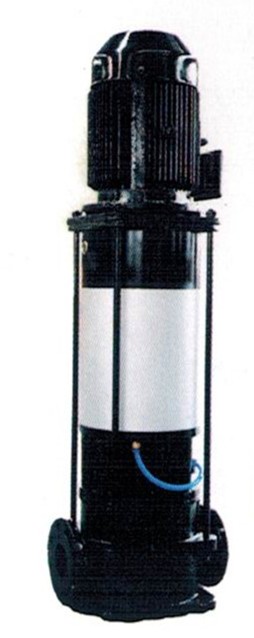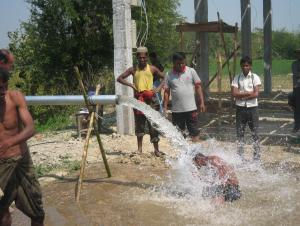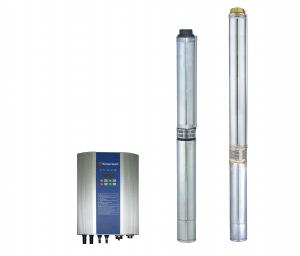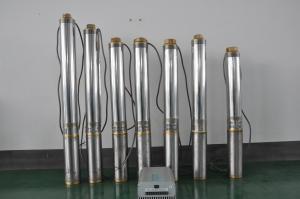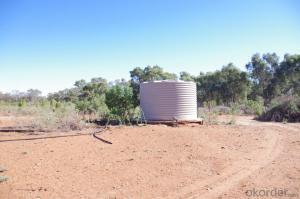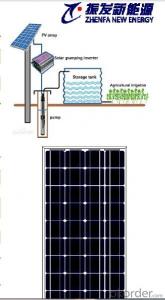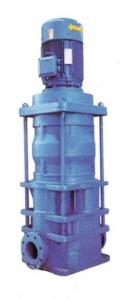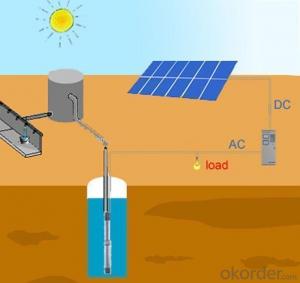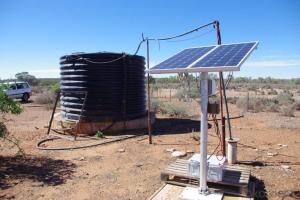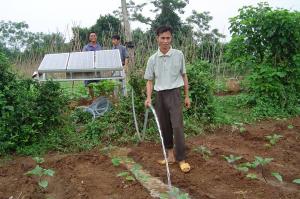Solar Pump Manufacturers L3D-5.5-320 Solar Water Pump
- Loading Port:
- China Main Port
- Payment Terms:
- TT OR LC
- Min Order Qty:
- -
- Supply Capability:
- 300 sets unit/month
OKorder Service Pledge
OKorder Financial Service
You Might Also Like
Product description:
Product: Solar water pump
Model:L3D-5.5-320
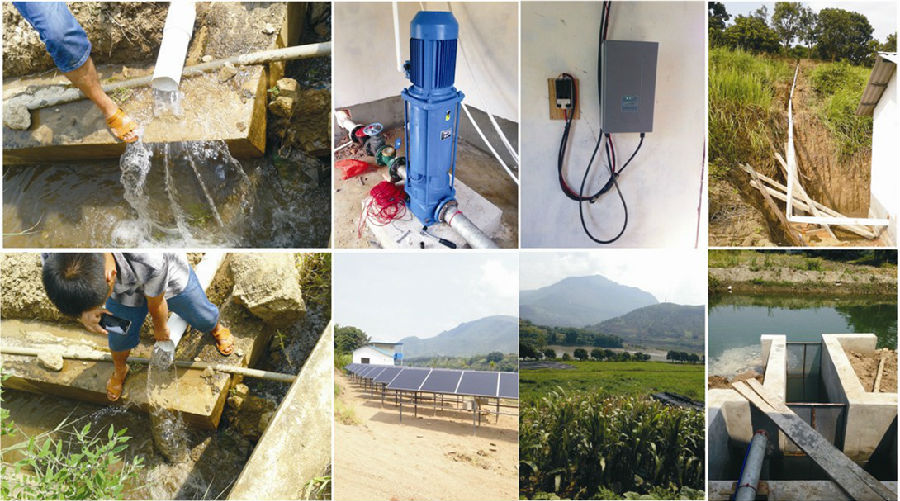 Appilication:
Appilication:
surface pump
for surface water of pond, river, lake
for irrigation of a big farm with3000 m2 on the top of a high mountain
Product specification:
flow rate:5.5m3/ hour, 44m3/day.
lift: 10m-320m
pump diameter: 296mm
Pump installed on the ground, outlet to the water surface:4m
with AC motor, motor power:5.5kW
but only need solar power:6kW(while Grundfos pump needs at least 25kW solar power, our pump can save more than 70% solar panel power,save USD12000 cost for solar panel per set.
Material:
Pump inside: stainless steel and wearable nylon,it enables our solar pump to have 10 years sevice life.
Motor : AC motor, 380V , three phase , 50Hz. The pump also can connect with grid power directly.
Certification:
3 International patent
ISO9001
CE
Warranty:2 years
- Q: Can solar pumps be used for water supply in agricultural fields or farms?
- Yes, solar pumps can be used for water supply in agricultural fields or farms. Solar pumps are an efficient and sustainable alternative to traditional pumps, as they harness energy from the sun to power the pumping system. This reduces the reliance on fossil fuels and lowers operational costs. Solar pumps can provide a reliable and continuous water supply for irrigation, livestock watering, and other agricultural activities, making them an ideal solution for farms and agricultural fields.
- Q: Can a solar pump be used for water supply in remote islands?
- Yes, a solar pump can certainly be used for water supply in remote islands. Solar pumps are a reliable and sustainable solution that can harness solar energy to draw water from underground sources, such as wells or boreholes, and supply it to communities or individuals living in remote areas. As long as there is sufficient sunlight, a solar pump can provide a consistent and cost-effective water supply, making it an ideal solution for remote islands where access to electricity or traditional water infrastructure may be limited.
- Q: Do solar pumps require batteries for storage?
- Solar pumps do not need batteries for storage. They are specifically designed to function by directly utilizing the energy produced by the sun. When the sun is present, the solar panels convert sunlight into electrical energy, which powers the pump. This enables the pump to operate in real-time, extracting water directly from the source and delivering it to the desired location, such as a reservoir or irrigation system. Because solar pumps do not depend on batteries for storage, they are generally more cost-effective and require less maintenance compared to pumps that rely on batteries. However, it is important to mention that certain solar pump systems may incorporate a small battery for short-term energy storage. This ensures uninterrupted operation during periods of low sunlight or at night.
- Q: Are there any limitations to the type of pump technology that can be used in a solar pump system?
- Yes, there are limitations to the type of pump technology that can be used in a solar pump system. One of the primary limitations is the power output of the solar panels. The pump technology used must be compatible with the power output of the solar panels in order to efficiently and effectively pump water or other fluids. Another limitation is the size and weight of the pump. Solar pump systems are often used in remote locations where transportation and installation can be challenging. Therefore, the pump technology used must be compact and lightweight to facilitate easy transportation and installation. Additionally, the type of fluid being pumped can also impose limitations on the pump technology. For example, if the fluid being pumped is corrosive, the pump technology used must be able to withstand the corrosive properties of the fluid. Furthermore, the depth and distance that the pump needs to move the fluid can also impact the type of pump technology that can be used. Different pump technologies have different limitations in terms of the maximum depth and distance they can effectively pump fluids. Lastly, budget constraints can also be a limitation when choosing the pump technology for a solar pump system. Some pump technologies may be more expensive than others, and the available budget may limit the options in terms of pump technology selection.
- Q: What is the expected impact of shading on the performance of a solar pump?
- The expected impact of shading on the performance of a solar pump is a reduction in its efficiency and overall output. Shading refers to any obstruction that blocks sunlight from reaching the solar panels of the pump. Since solar pumps rely on solar energy to generate electricity, shading can significantly affect their performance. When shaded, the solar panels receive less sunlight, which leads to a decrease in power production. This reduction in power output directly translates to a decrease in the pumping capacity of the system. The shaded area on the solar panels creates a bottleneck for the flow of electricity, causing a drop in the pump's overall efficiency. The impact of shading can be further intensified if the shading occurs during peak sunlight hours. This means that the pump's performance will be most affected during the times when solar energy is readily available. Shading can also cause temperature imbalances on the solar panels, leading to hot spots and potential damage to the system. To mitigate the impact of shading, proper site selection and panel orientation are crucial. By placing the solar panels in an area with minimal shading, such as an open field or rooftop, the system can maximize its exposure to sunlight. Implementing a tracking system that adjusts the panel's position throughout the day can also help minimize shading effects. In conclusion, shading has a negative impact on the performance of a solar pump, resulting in reduced efficiency and output. Proper planning and positioning of the solar panels can help minimize shading and optimize the pump's performance.
- Q: Can a solar pump be used in areas with high levels of lead in the water?
- Yes, a solar pump can be used in areas with high levels of lead in the water. However, it is important to note that a solar pump alone cannot remove lead from water. To ensure safe drinking water, additional water treatment methods such as using activated carbon filters or reverse osmosis systems might be required to effectively remove lead contaminants from the water.
- Q: Can a solar pump be used for water circulation in a cooling tower or industrial process?
- Yes, a solar pump can be used for water circulation in a cooling tower or industrial process. Solar pumps are designed to harness the energy from the sun and convert it into mechanical energy to circulate water. They are commonly used in various applications, including irrigation, water supply, and cooling systems. In the case of a cooling tower or industrial process, a solar pump can be utilized to circulate water within the system. The pump can draw water from a source, such as a reservoir or a well, and then distribute it throughout the cooling tower or industrial process, ensuring a continuous flow of water for cooling or other industrial needs. The advantages of using a solar pump in these applications are numerous. Firstly, solar pumps are eco-friendly as they derive their power from the sun, reducing dependence on fossil fuels and minimizing greenhouse gas emissions. This aligns with the growing trend towards sustainable and renewable energy sources. Secondly, solar pumps often have low operating costs as they do not require electricity from the grid. Once the initial investment in the solar pump system is made, the ongoing operational expenses are minimal, resulting in cost savings over time. Additionally, solar pumps are typically reliable and require minimal maintenance. They are designed to withstand harsh environmental conditions and can operate efficiently even in remote locations where access to electricity may be limited. In summary, a solar pump can certainly be used for water circulation in a cooling tower or industrial process. It offers the benefits of sustainability, cost-effectiveness, and reliability, making it a viable option for various industrial applications.
- Q: Can a solar pump be used for irrigation?
- Yes, a solar pump can be used for irrigation. Solar pumps are capable of utilizing solar energy to power water pumps, allowing for efficient and sustainable irrigation systems. These pumps can provide a reliable source of water for agricultural purposes, reducing the dependency on traditional energy sources and minimizing environmental impact.
- Q: How does a solar pump handle water source contamination from nuclear power plants?
- A solar pump does not directly handle water source contamination from nuclear power plants. Its primary function is to harness solar energy to pump water from a source, such as a well or river, and does not have the ability to address or mitigate contamination caused by nuclear power plants. Handling water source contamination from nuclear power plants requires specialized systems and processes designed to treat and purify the water to remove any radioactive substances or pollutants.
- Q: How does a solar pump handle water with high levels of nitrates or other contaminants?
- A solar pump is primarily designed for water pumping purposes and does not have a built-in mechanism to handle high levels of nitrates or other contaminants. If the water being pumped contains high levels of nitrates or other contaminants, additional water treatment methods such as filtration or chemical treatments may be required to ensure the water is safe for use.
Send your message to us
Solar Pump Manufacturers L3D-5.5-320 Solar Water Pump
- Loading Port:
- China Main Port
- Payment Terms:
- TT OR LC
- Min Order Qty:
- -
- Supply Capability:
- 300 sets unit/month
OKorder Service Pledge
OKorder Financial Service
Similar products
Hot products
Hot Searches
Related keywords

